|
On July 3rd, show your support for our Great Lakes, and water protection more generally. Like-minded people all around the lakes will SHOW UP to make their support visible by attending events at 10 am (Eastern Time) to join hands and pass a marble.
Events are already planned in many locations, but if there isn't an event near you, you are invited to organize one. This would be a terrific, quick project for a local League! All the information, including locations, is available from All Hands on Deck. The Great Lakes are a global hub of oil refining. There are many pipelines traversing the state of Michigan. In 2010, a pipeline (6B) owned by Enbridge discharged over 1 million gallons into the Kalamazoo River. A series of dams prevented it from reaching Lake Michigan, but the damage was extensive.This was the warning that awoke Michigan’s concerns. Enbridge made the largest settlement for the largest inland “spill”. It must be told that not all the oil was removed. Because this was a heavy tar sands oil, it dropped to the bottom of the river, trapped in sediment. After extensive dredging, it was determined that to do anymore, would cause great harm to the river’s ecosystem. Lessons learned from this accident demonstrated that Enbridge’s claims that they employ technology designed to detect and shut down the oil flow, should such an event occur, is not true.The Kalamazoo River oil discharge went on for 17 hours before residents reported the leak. The 2010 Kalamazoo River discharge prompted a National Wildlife Federation review of existing pipelines in Michigan. One pipeline was highlighted because of it’s age and location. Pipeline 5 travels from Wisconsin, through the Upper Peninsula of Michigan, under the Straights of Mackinac through the Lower Peninsula and exits at a refinery in Sarnia, Ontario. It is estimated that only 5-10% of this oil is used by Michigan. The rest is shipped, with a great deal going to Great Britain. The pipeline portion under the Straights of Mackinac become a set of twin pipelines running 5 miles. They are 64 years old and carry over 500,000 barrels of light crude oil and natural gas per day. The transport of liquified natural gas through pipeline, as occurs here, is unusual. About half of this natural gas is used to heat rural, upper Michigan homes. These needs can be addressed by other transportation modes such as rail and truck. It would take 4-5 tanker trucks or 1-2 rail cars daily. A 2014 study by the University of Michigan found that the Straights of Mackinac are the “worst possible place” for an oil spill in the Great Lakes. The shifting currents where Lake Michigan and Lake Huron meet are 10X the force of Niagara Falls. An easement agreement with the State of Michigan requires support bracing every 75 feet. Enbridge has been out of compliance many times and frequently needs to apply for permits to add the required anchors. The strong, shifting currents create an unstable bottomland. Response to a clean-up incident during the winter when the Straights are frozen, would be impossible. The harsh currents at this location would make containment unmanageable. Anti-corrosive coatings are missing in 19 areas. Enbridge’s response to State of Michigan requests for inspection information has been difficult. As a lobby group they proposed legislation to protect themselves from FOIA requests due to national security concerns. Regulation of pipelines is done by the federal government. But the State of Michigan has responsibility for this portion of the bottomlands of the Great Lakes through the Public Trust Doctrine. All other pipeline disputes involve installation of new pipeline. This is the first challenge to an existing pipeline. The Governor established a Michigan Pipeline Advisory Board in 2015. Two studies were commissioned. An alternatives analysis will evaluate alternative routes or complete replacement of the pipeline. The risk analysis study will establish adequate financial assurance should a discharge occur. These studies are being conducted by private contractors, hired by Enbridge. They are due the end of June. Enbridge will have the opportunity to review, before it is submitted to the state. The contractors will present the draft on July 6, 2017, when public comment will begin. Public hearings will be held on July 24-25. After the public comment period concludes, the state will prepare their recommendations with a final draft in the Fall. Information on the pipeline and comment process can be found at: www.oilandwaterdontmix.org LWVMI has joined the Oil and Water Don’t Mix Coalition and is on the steering committee. We support the decommissioning of Pipeline 5. We support Senator Rick Jones’(R) and Senator Steve Bieda’s (D), SB 292.
LWVMI supports House Resolution 0051 (2017) urging the Governor and Attorney General to exercise their authority, immediately, to terminate the 1953 easement and shut down Enbridge Line 5 under the Straights of Mackinac. This has been referred to the House Policy Committee. Both Senators Stabenow and Peters introduced a package of bills that would increase pipeline safety in and around the Great Lakes and account for the unique needs of the Great Lakes ecosystem. The bills would:
This proposal builds on a previous bill they passed in 2015, which was signed by President Obama. The Protecting Our Infrastructure of Pipelines and Enhancing Safety Act, or PIPES Act. This Act strengthened pipeline oversight and improves response plans for oil spills under ice-covered waters. Thanks to Suzanne Dixon, a representative to the LWVLMR Board from Michigan, for submitting this article. 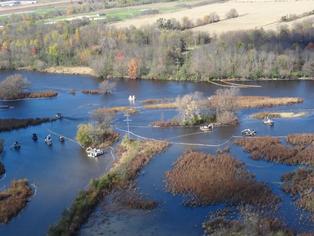 2011 clean up work of the Enbridge oil spill (credit: www.michigan.gov at http://bit.ly/29VG65p) 2011 clean up work of the Enbridge oil spill (credit: www.michigan.gov at http://bit.ly/29VG65p) The LWV Lake Michigan Region Annual Meeting in Douglas, Michigan back in 2011 included a paddleboat cruise on the Kalamazoo River, narrated by LWVMI delegate Suzanne Dixon. Instead of talking about the natural beauty or a thriving local ecosystem, our group learned about the environmental disaster caused by the oil spill from an Embridge pipe leak. Today, the U.S. EPA and the Dept. of Justice today announced a settlement with Enbridge Energy Limited Partnership (and several related companies) to resolve claims stemming from its 2010 oil spills in Marshall, MI and Romeoville, IL. Enbridge has agreed to spend at least $110 million on measures to prevent spills and improve operations across nearly 2,000 miles of its pipeline system in the Great Lakes region. These measures include:
Enbridge will also pay civil penalties totaling $62 million for Clean Water Act violations. Enbridge has already reimbursed the government for $57.8 million in cleanup costs from the Marshall spill and $650,000 for cleanup costs from the Romeoville spill, and Enbridge reportedly incurred costs in excess of $1 billion for required cleanup activities for these spills. “This was one of the largest inland oil spills in U.S. history when Enbridge discharged one million gallons of oil to Talmadge Creek near Marshall,” said acting EPA Regional Administrator Robert Kaplan. “Together with our state and local emergency responders, EPA was able to contain the spill before it reached the Great Lakes. After 22 months of arduous cleanup work, the Kalamazoo River finally reopened for recreational activities.” The government’s complaint alleges that on July 25, 2010, Enbridge's 30 inch-pipeline known as Line 6B discharged at least 20,082 barrels of crude oil, much of which entered Talmadge Creek and flowed into the Kalamazoo River which flows to Lake Michigan. Flooding caused by heavy rains pushed the discharged oil over the river's banks into its flood plains, and accelerated its migration over 35 miles downstream before it was contained. Line 6B, which originates in Griffith, IN, crosses the lower peninsula of Michigan and ends in Sarnia, Canada, has since been replaced with a new, larger pipeline, also known as Line 6B. The complaint also alleges that on September 9, 2010, another Enbridge pipeline, known as Line 6A, discharged at least 6,427 barrels of oil in Romeoville, IL, much of which flowed through a drainage ditch into a retention pond in Romeoville. There will be a 30 day public comment period on the consent decree. Information on how to comment will be available in the Federal Register and on the Department of Justice’s website: www.justice.gov/enrd/consent-decrees. More info on the settlement is available at https://www.epa.gov/enforcement/enbridge-clean-water-act-settlement 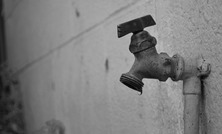 As the terrible news about the Flint, Michigan water crisis flooded the media, the well-being of our colleagues in the League of Women Voters of Flint was among our concerns. Now the LWV of Flint, a member of LWVLMR, has released, The Flint Water Crisis: A Summary Report. The report concisely explains how elevated lead levels in the public water supply became a public health crisis for the residents of Flint. The Flint League notes for the record that LWV of Michigan opposed Michigan's Emergency Management law, which enabled the cascade of fateful decisions that led to the emergency. Sadly, they report that some residents are still not educated about the dangers of lead or about the measures individuals can take to help protect themselves and their children from those dangers. LWV Flint is doing its part to aid the community by sharing information and by registering residents to vote. We highly recommend reading the report in full. Congratulations to the Healing Our Waters Coalition for organizing a terrific Great Lakes Days event in Washington DC. Leaguers played an important part of this group of over 100 Lake lovers who convened in February to get updates on the successes of the Great Lakes Restoration Initiative, hear speakers, and participate in in-person meetings with elected representatives and staff on Capitol Hill. One of our most effective handouts for making our case is a description of restoration successes from around the Great Lakes region, which can be accessed here .
The Great Lakes Restoration Initiative (GLRI) is an inter-agency program designed to address the most significant problems in the Great Lakes and works to protect, restore and maintain the Great Lakes Ecosystem. It has traditionally enjoyed bi-partisan support. At our Congressional breakfast both Republicans and Democrats from both Houses addressed the group in support of our work. Unfortunately, President Obama’s current budget requests only $250 million for FY 2017. We were lobbying to have that amount restored to $300 million to maintain the current level of funding because, although GLRI is showing real and measurable results, there is still plenty of work to be done. LWVLMR supports authorization and multi-year funding of $300 million per year for the GLRI and encourages you to contact your federal legislators in support of this position. The visit was timely as there is heightened concern about drinking water across the states, due to the crisis in Flint, MI. So in addition to the request for GLRI support, we were also asking for a boost to the Clean Water and Drinking Water State Revolving Fund programs that help local communities upgrade aging water infrastructure to protect drinking water, reduce sewer overflows, and prevent beach contamination. Additionally, protection against Asian carp and other invasive species coming through the Chicago Area Waterways was sought, with emphasis on speeding up the Brandon Road Feasibility study by the Army Corps of Engineers. Brandon Road is the site of a Lock and Dam on the Illinois River and was identified as a possible choke point to stop the fish in a previous study which we lobbied for. All of our Great Lakes LWV states except Pennsylvania are members of the Healing Our Waters Coalition. Their annual conference will be September 20-22, 2016 in Sandusky, OH this year and we encourage League members to attend.  Yes, you have unwanted/unneeded/expired drugs. Keep them out of our waters! Yes, you have unwanted/unneeded/expired drugs. Keep them out of our waters! If you are like us, April means its Drug Take Back time, and you are in the habit of going through your prescription and over-the-counter drug containers to weed out the expired and unneeded drugs. That is still a good idea, but this year you may have to rethink where you will bring the drugs for safe disposal so they stay out of our freshwater sources. After organizing highly successful National Drug Take Back Days in April and October of the last four years, the Drug Enforcement Agency (DEA) has discontinued the program. Ongoing local collection sites are now available thanks to the Secure and Responsible Drug Disposal Act of 2010. To find a drug collection site near you, search the DEA's database, or find a site run by Yellow Jug Old Drugs®, a collection program operated by the Great Lakes Clean Water Organization in Wisconsin, Illinois, Indiana, Michigan and Ohio. In case you were wondering if the 2014 annual meeting is worthy of your October 3-5 weekend, heed Traverse City Record-Eagle reporter Marta Hepler Drahos. She wrote in a September 19 story, that "The speakers list reads like a 'Who’s Who in Michigan Conservation' directory."
You can't do much better than that! Well done, Annual Meeting co-chairs Ruth Caputo and Mary Lee Orr. So if you haven't already, register now, because Thursday (9/25) is the deadline! 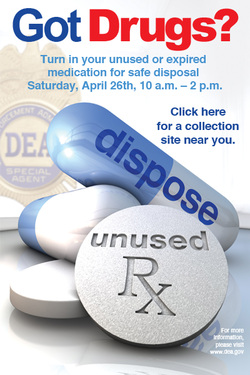 We now know that unsafe methods of disposing of unused medicines— like flushing the drugs down the toilet or throwing them in the trash--may lead to drugs entering our freshwater supplies. On April 26 from 10 a.m. to 2 p.m., the Drug Enforcement Administration (DEA) will work with local partners to give the public a safer way of ridding their homes of potentially dangerous expired, unused, and unwanted prescription drugs. Bring your pills and patches to a collection site for disposal. The service is free and anonymous, no questions asked. Click the Got Drugs? button to find the most convenient site near you. Over the last 4 years, over 3.4 million pounds—more than 1,700 tons—of pills have been safely disposed through this program! That's a big win for clean water! 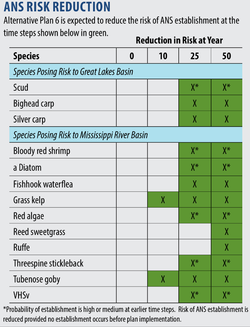 From the GLMRIS report at http://glmris.anl.gov/glmris-report/ From the GLMRIS report at http://glmris.anl.gov/glmris-report/ The U.S. Army Corps of Engineers accepted public comments on its Great Lakes-Mississippi River Interbasin Study (GLMRIS) Report through the month of March. LWV Illinois, LWV Wisconsin and LWV Michigan each submitted letters supporting hydrologic separation to prevent the transfer of invasive species between the Mississippi River watershed and the Lake Michigan watershed. USACE analyzed the expected effectiveness of eight different scenarios that might be used to control the spread of aquatic nuisance species. The analysis is based on the 13 species, listed in the chart at right, that are considered the most risky. The two plans that include permanent barriers between the watersheds are the only ones that are effective against all species, according to the government's analysis. The Leagues' actions were based on their respective Great Lakes Ecosystem positions. |
Archives
December 2017
Categories
All
|

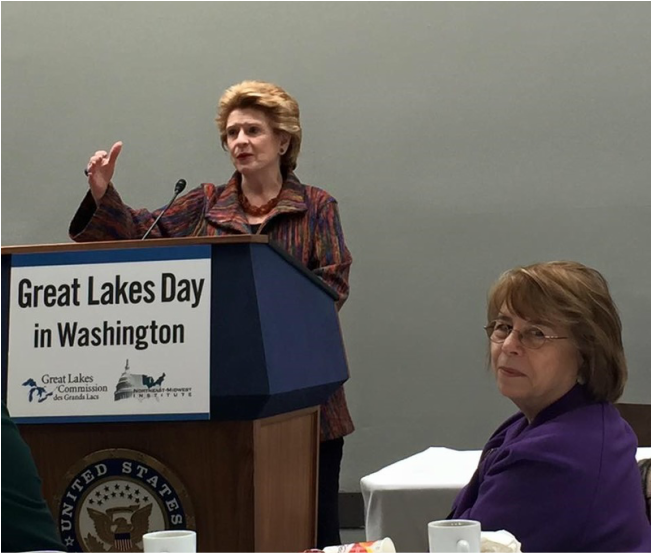
 RSS Feed
RSS Feed